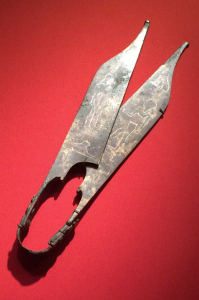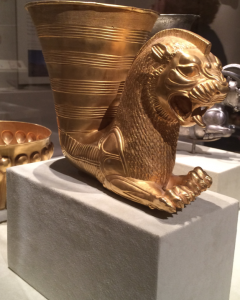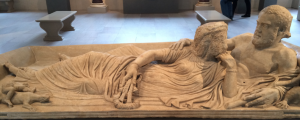One of the fascinating aspects about the ancient world is the artifacts that still remain. Preservations of the past leave behind traces of our existence and the journey of humanity from prehistoric times to the modern world. By looking at the history of certain objects at the Metropolitan Museum of Art from the Egyptian, Near Ancient Eastern, and Greek and Roman eras, it shows us a true-to-life depiction of the earliest evidence of humankind. With the closer inspection of each item, it tells a rich and archival story of its use or significance to that period.
The Met’s collection of Egyptian art is one of the biggest galleries in this museum. With about 26,000 pieces of Egyptian artifacts, it was almost impossible to choose only one item. However, upon exploring the entire exhibit there was one object I kept circling back to. A simple pair of shears, made of bronze or copper alloy, silver, black copper that dated back to approximately A.D. 2nd centuries ago, caught  my attention. The copper alloy has long rusted and parts have been chipped away, but the hieroglyphic art still remains. Small areas of paint stay intact and reveal muted colors of crimson, teal, and gold. On both pieces of the shears depict a three different figures. From reading the description, I learned that the creator of the shears added a humorous aspect to the piece. For instance, when the shears are closed the dog figure on top faced a cat figure while on the bottom it faced a lion figure. I thought the idea of adding a lighthearted story to the shears was fascinating and kept drawing me back. This object reminded me most of in my studies is the “Palette of King Narmer.” Both the shears and the palette are typically used as a daily object in the lives of ancient Egyptians. What’s interesting about both objects is that they depict minimally decorated figures that often tell a story or used ritualistically. While one portrayed the story of King Narmer, the other could have functioned as a ritual item in an Isis sanctuary.
my attention. The copper alloy has long rusted and parts have been chipped away, but the hieroglyphic art still remains. Small areas of paint stay intact and reveal muted colors of crimson, teal, and gold. On both pieces of the shears depict a three different figures. From reading the description, I learned that the creator of the shears added a humorous aspect to the piece. For instance, when the shears are closed the dog figure on top faced a cat figure while on the bottom it faced a lion figure. I thought the idea of adding a lighthearted story to the shears was fascinating and kept drawing me back. This object reminded me most of in my studies is the “Palette of King Narmer.” Both the shears and the palette are typically used as a daily object in the lives of ancient Egyptians. What’s interesting about both objects is that they depict minimally decorated figures that often tell a story or used ritualistically. While one portrayed the story of King Narmer, the other could have functioned as a ritual item in an Isis sanctuary.
Other than the extensive Egyptian art at the Met, the Ancient Near Eastern galleries housed some of the most eccentric artifacts that date back from the eighth millennium B.C. all the way to seventh century A.D. Since the Ancient Near Eastern region was vast and ran between the Tigris and Euphrates rivers, there was a great range of art that represents the people and their culture during this time. One particular object that stood out to me was a golden drinking vessel called the “Vessel terminating in the forepart of a fantastic leonine creature.” Found in modern day Iran, the horn-shaped vessel was part of the Achaemenid culture, perhaps it was even owned by the Achaemenid king. I realized that this object would be an excellent example of Ancient Near Eastern art. By physically observing the object, one can further examine the fine skill and artistic mastery that went along soldering this vessel. It depicts the frontal portion of a ferocious lion with wings that signify its supernatural importance. Gold wires were wrapped and twisted around the goblet part of the vessel in forty-four even rows. In Near Eastern culture, kings are more important compared to deities. As a result, animal-headed art, like the “Panels with Striding Lions” and “Lamassu,” are often owned and made for kings of the Achaemenid, Seleucid, and Parthian periods.
range of art that represents the people and their culture during this time. One particular object that stood out to me was a golden drinking vessel called the “Vessel terminating in the forepart of a fantastic leonine creature.” Found in modern day Iran, the horn-shaped vessel was part of the Achaemenid culture, perhaps it was even owned by the Achaemenid king. I realized that this object would be an excellent example of Ancient Near Eastern art. By physically observing the object, one can further examine the fine skill and artistic mastery that went along soldering this vessel. It depicts the frontal portion of a ferocious lion with wings that signify its supernatural importance. Gold wires were wrapped and twisted around the goblet part of the vessel in forty-four even rows. In Near Eastern culture, kings are more important compared to deities. As a result, animal-headed art, like the “Panels with Striding Lions” and “Lamassu,” are often owned and made for kings of the Achaemenid, Seleucid, and Parthian periods.
Lastly, Greek and Roman art was a major period that we focused on for Unit 3. With the Met’s wide variety of Roman and Greek sculptures, it was simple finding one that caught my eye. The one on the right is called “Marble sarcophagus lid with reclining couple.” It is made of marble since it’s a Roman copy of a Greek sculpture. Sheaves of wheat were sculpted into the woman’s hand as a tribute to the goddess of the earth, Tellus. Underneath their fee t is a miniature mammal with Eros riding atop his back. This particular sculpture reminded me of “Marble sarcophagus lid with reclining couple,” an object we examined in class. Not only do both feature a male and a female figure, but they were also used for funerary purposes. What initially attracted me to this piece was the woman’s unfinished face. It’s an important feature of this sculpture because it serves as a clue on the woman’s role in Roman society as compared to the man’s.
t is a miniature mammal with Eros riding atop his back. This particular sculpture reminded me of “Marble sarcophagus lid with reclining couple,” an object we examined in class. Not only do both feature a male and a female figure, but they were also used for funerary purposes. What initially attracted me to this piece was the woman’s unfinished face. It’s an important feature of this sculpture because it serves as a clue on the woman’s role in Roman society as compared to the man’s.
Overall, the experience of seeing the objects compared to discussing them in class makes a huge difference. From the genuine democracy of the Romans to the funerary processions of the Egyptians, one can glimpse into the earliest evidence of human history through the galleries at the Met. All the artifacts from the Egyptian, Ancient Near Eastern, and Greek and Roman periods shared something in common. They were all trying to perfect the human anatomy through art. Like the “Lamassu,” one can see the emphasize on frontal and profile views once they visit the Met.

